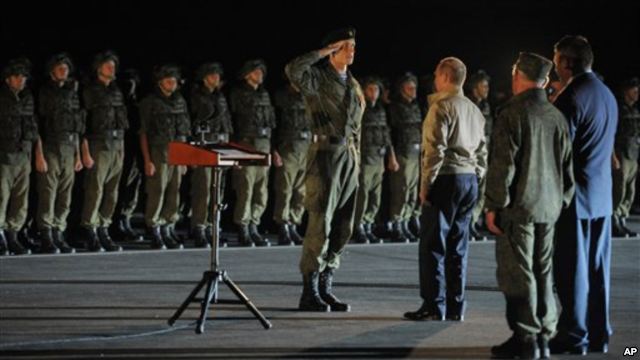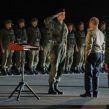
CSTO Exercises Rapid Reaction Forces in Armenia
Publication: Eurasia Daily Monitor Volume: 9 Issue: 169
By:

Russia is staging a number of military exercises in September and October as part of the training year for its Armed Forces, designed to road test elements of its ongoing conventional forces reform, promote defense cooperation and strengthen the Collective Security Treaty Organization (CSTO). Although the operational-strategic exercise, Kavkaz-2012, held in Russia’s South Military District (MD) is likely to receive much greater attention due to its scale and possible strategic implications, the smaller CSTO exercise in Armenia is arguably more significant and complex (Interfax, September 17).
The CSTO exercise in Armenia, Vzaimodeistviye-2012, held from September 15 to September 19, is designed to test the organization’s 20,000-strong Collective Rapid Reaction Forces (Kollektivnye Sily Operativnovo Reagirovaniya—KSOR), at a time when the need for a display of CSTO unity is vital following Uzbekistan suspending its membership on June 20. However, this exercise, long planned and part of the pattern of annual joint training for the KSOR, is also part of the wider summer military training program for the Russian Armed Forces and needs to be understood in this broader context (Interfax, September 4).
In July, joint exercises were held between Kazakhstan and Russia—the operational-tactical command post exercise, Aldaspan-2012. Also in July, Slavyanskoye Sodruzhestvo-2012 was staged in Ukraine involving a Ukrainian-Belarusian-Russian tactical training exercise. The Indra-2012 joint Russian-Indian training exercises were held in the Eastern MD, and Russia will hold an annual joint exercise with Mongolia this month, Selenga-2012. While by October in Kazakhstan, the first joint exercise for CSTO peacekeepers will be staged. Among these exercises, by far the greatest attention and controversy surrounded Kavkaz-2012, with NATO calling on Moscow for more transparency concerning that exercise (Krasnaya Zvezda, June 14).
The operational-strategic exercise Kavkaz-2012 started on September 17 and will conclude in southern Russia on September 23. According to Army-General Nikolai Makarov, the Chief of the General Staff, the exercise will involve 8,000 personnel, 200 military vehicles, 100 artillery pieces and 10 combat vessels; it will include defense ministry forces and other security forces drawn from the power ministries such as the Federal Security Service (FSB) and the interior ministry (RIA Novosti, September 17).
In this wider scheme of Russian military training, it would be easy to overlook the significance of the CSTO’s KSOR exercise in Armenia. Despite the Armenian defense ministry postponing the start of the exercise from September 8 to September 15, Vzaimodeistviye-2012 is unique for a number of reasons. KSOR has held annual military exercise since its formal creation as a new CSTO force in June 2009, but this exercise marks its first use in the South Caucasus. It also comes at a time when the CSTO is in crisis in the aftermath of Tashkent’s suspension of membership, with its official exit from the organization expected to be accepted by the other members later this year. Finally, the force structure and countries represented in Vzaimodeistviye-2012 raises salient questions about whether some CSTO members would operationally deploy forces to the South Caucasus during a crisis, and if so what that might involve (Interfax, September 17).
A spokesman for the CSTO explained that KSOR would tactically deploy to Armenia during the exercise, which involves 2,000 personnel. The force consists of defense ministry elements supported by Special Forces drawn from Armenia, Belarus, Kazakhstan, Kyrgyzstan, Russia and Tajikistan; the exercise is attended by representatives of the International Committee of the Red Cross and observers from the UN, OSCE and the CIS (Interfax, September 4).
Armenian Defense Minister Seyran Ohanyan welcomed the servicemen participating in the military drills and expressed his support for the KSOR: “CSTO Rapid Reaction Forces are serious regional forces and can withstand potential hazards. The military drills show how six countries may unite for collective security reasons.” A statement by the Armenian foreign ministry outlined background details about the KSOR, stressing that the 20,000-person force is combat capable and that each CSTO member state attaches importance to this structure and remains committed to further strengthening it (www.armenpress.am, September 15). According to Armenian officials, the military and security personnel also competed in various sports, including rope tugging, soccer and volley ball.
Preparations for the exercise have proved to be extensive, with Russia hosting pre-exercise training for the force elements at the base of the 98th Airborne Division in Ivanovo and with the 31st Air Assault Brigade. The command elements of these elite airborne formations were also holding command-staff training alongside the command-and-control parts of the CSTO forces earmarked for the exercise in Armenia (Krasnaya Zvezda, June 14).
While much attention has been given to Kavkaz-2012, the CSTO military exercise in Armenia is certainly no less important, not least in testing the KSOR but also in the display of political willingness for the CSTO to act in the South Caucasus. Since the KSOR is mandated to act across a wide spectrum of crises ranging from a domestic political crisis to emergency situations or combating terrorism and drug trafficking, the potential for it to see real action has certainly grown compared to the more narrow focus the CSTO has traditionally placed on protecting members from “external aggression.” Nonetheless, given the fact that none of the CSTO members recognized the independence of Abkhazia or South Ossetia, it is unclear what the precise circumstances might involve in order to convince Central Asian members to send forces to a crisis or conflict situation in the South Caucasus.




